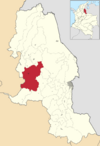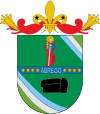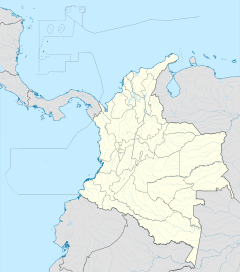Ábrego facts for kids
Quick facts for kids
Ábrego
|
|||
|---|---|---|---|
|
Municipality
|
|||
 |
|||
|
|||

Location of Ábrego in Norte de Santander
|
|||
| Country | |||
| Department | Norte de Santander | ||
| Subregion | Western | ||
| Founded | 12 March 1810 | ||
| Area | |||
| • Total | 1,582 km2 (611 sq mi) | ||
| Elevation | 1,398 m (4,587 ft) | ||
| Population
(2015)
|
|||
| • Total | 38,627 | ||
| • Density | 24.417/km2 (63.239/sq mi) | ||
| Time zone | UTC-5 (Colombia Standard Time) | ||
| Climate | Aw | ||
Ábrego is a town and municipality in Colombia. It is located in the Norte de Santander department. This town sits high up in the Eastern Andes Mountains. It is about 1,398 metres (4,587 ft) above sea level. Ábrego is a vibrant place with a rich history and beautiful nature.
Contents
Discovering Ábrego's Past
Ábrego has a long and interesting history. Long ago, different groups of native people lived here. These included the Oroques, Turmeros, Seborucos, and Carasicas. In 1530, European explorers arrived. They called the area "Llano de los Orejones".
How Ábrego Got Its Name
On July 26, 1580, a wooden cross was placed in the valley. This was for the first religious ceremony. After this, the place became known as "Llanos de la Cruz". The town started to grow when two sisters, Ana María and Josefa de la Encarnación Maldonado Quintero, gave land for people to build homes. Streets and squares were then created.
The official founding date of the municipality is March 12, 1810. Later, on April 14, 1930, the town's name changed to Ábrego. This was to honor Mercedes Abrego de Reyes. She was a brave woman from the Norte de Santander region and is seen as a local hero.
The Geography of Ábrego
Ábrego is located in a special natural area. A small part of the municipality, about 3 hectares, is in the Santurbán moor. This moor is very important because it provides water for two departments: Norte de Santander and Santander.
The town itself is nestled in a valley. This valley lies between two rivers, the Oroque River and the Frío River. This location gives Ábrego a unique landscape.
Ábrego's Weather
| Climate data for Ábrego | |||||||||||||
|---|---|---|---|---|---|---|---|---|---|---|---|---|---|
| Month | Jan | Feb | Mar | Apr | May | Jun | Jul | Aug | Sep | Oct | Nov | Dec | Year |
| Mean daily maximum °C (°F) | 26.6 (79.9) |
27.2 (81.0) |
27.6 (81.7) |
27.2 (81.0) |
27.1 (80.8) |
27.3 (81.1) |
27.6 (81.7) |
27.8 (82.0) |
27.1 (80.8) |
26.6 (79.9) |
26.2 (79.2) |
26.1 (79.0) |
27.1 (80.8) |
| Daily mean °C (°F) | 20.1 (68.2) |
20.5 (68.9) |
21.0 (69.8) |
21.2 (70.2) |
21.3 (70.3) |
21.3 (70.3) |
21.3 (70.3) |
21.3 (70.3) |
21.0 (69.8) |
20.9 (69.6) |
20.7 (69.3) |
20.3 (68.5) |
20.9 (69.6) |
| Mean daily minimum °C (°F) | 12.3 (54.1) |
12.7 (54.9) |
13.4 (56.1) |
14.5 (58.1) |
14.8 (58.6) |
14.1 (57.4) |
13.5 (56.3) |
13.7 (56.7) |
14.3 (57.7) |
14.3 (57.7) |
14.1 (57.4) |
13.1 (55.6) |
13.7 (56.7) |
| Average precipitation mm (inches) | 9.5 (0.37) |
19.1 (0.75) |
28.9 (1.14) |
110.7 (4.36) |
170.1 (6.70) |
96.0 (3.78) |
87.4 (3.44) |
144.7 (5.70) |
210.1 (8.27) |
165.8 (6.53) |
76.9 (3.03) |
23.6 (0.93) |
1,142.8 (44.99) |
| Average precipitation days | 3 | 4 | 6 | 12 | 18 | 12 | 12 | 16 | 20 | 19 | 13 | 5 | 133 |
| Average relative humidity (%) | 80 | 79 | 79 | 81 | 83 | 81 | 78 | 78 | 81 | 83 | 83 | 83 | 81 |
| Mean monthly sunshine hours | 217.0 | 175.0 | 170.5 | 135.0 | 145.7 | 165.0 | 189.1 | 173.6 | 144.0 | 145.7 | 156.0 | 189.1 | 2,005.7 |
| Mean daily sunshine hours | 7.0 | 6.2 | 5.5 | 4.5 | 4.7 | 5.5 | 6.1 | 5.6 | 4.8 | 4.7 | 5.2 | 6.1 | 5.5 |
| Source: Instituto de Hidrologia Meteorologia y Estudios Ambientales | |||||||||||||
Ábrego has a tropical savanna climate. This means it is generally warm all year round. The average temperature is about 20.9 degrees Celsius (69.6 degrees Fahrenheit).
Rainfall in Ábrego
The town experiences both dry and wet seasons. Some months, like May and September, receive a lot of rain. Other months, like January and December, are much drier. On average, Ábrego gets about 1142.8 mm (45 inches) of rain each year.
Ábrego's Economy
The economy in Ábrego mainly relies on farming. Many different crops are grown here.
Main Crops and Businesses
- The most important crop is onions.
- Other important crops include tomatoes, cocoa, coffee, and corn.
- Beans, sugar cane, and tobacco are also grown.
Besides farming, Ábrego has many small businesses. In 2017, there were 677 different shops and services. These included clothing stores, hairdressers, cafes, and bakeries.
Exploring Ábrego's Heritage Sites
Ábrego is home to several interesting historical and cultural places. These sites tell stories about the town's past.
Important Churches
- The Parish of Santa Bárbara is the oldest church in Ábrego. It was finished in 1765. It became a main church on September 5, 1807. This church is now considered a special cultural building for the department.
- The Divino Niño Church is another important temple. It was built by a priest named Diógenes Sanabria. The church was officially opened in 2009.
Unique Natural Attractions
- Pozo del Burro (The Donkey's Well) is a local legend. People say a traveler's donkey, carrying gold, drowned in the river here.
- Piedras Negras (Black Stones) is a large area covered with many dark stones. Some people think they came from a volcano or even an asteroid. An old story says the Oroques, a native group, used these stones for special rituals.
Natural Reserves of Ábrego
Ábrego is proud of its natural beauty and protected areas. These reserves help keep the environment healthy.
The Juridiscciones Moor
One important natural reserve is the Juridiscciones Moor. It covers about 2,800 hectares (about 6,900 acres). This moor is where the Oroque and Frío rivers begin. These two rivers then join to form the Algodonal River.
In 2014, the Juridiscciones, Santurbán, and Berlín Moors were officially protected. This moor complex has many lagoons. These lagoons are vital water sources for several towns in Norte de Santander, including Ábrego.
Education in Ábrego
Education has been important in Ábrego for a long time. The first schools opened in 1844.
Modern Schools in Ábrego
- The Carlo Julio Torrado Peñaranda School is a large, modern school. It opened in 2016. This "mega school" has three computer rooms. It also has labs for physics, chemistry, and biology. In 2016, about 1,600 students attended this school.
- The Institución Educativa Colegio Santa Barbara is another key school. It was founded in 1966. In 2016, the school celebrated its 50th anniversary in the town's main park.
See also
 In Spanish: Ábrego (Norte de Santander) para niños
In Spanish: Ábrego (Norte de Santander) para niños




